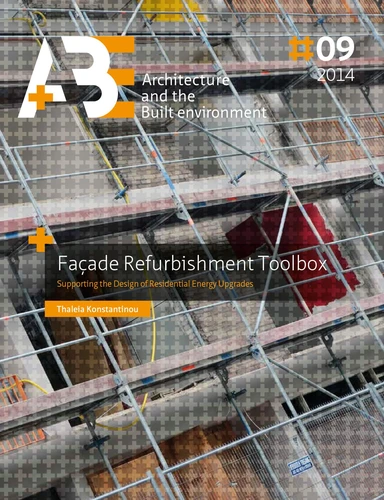Facade Refurbishment Toolbox.. Supporting the Design of Residential Energy Upgrades
Par :Formats :
Disponible dans votre compte client Decitre ou Furet du Nord dès validation de votre commande. Le format Multi-format est :
- Pour les liseuses autres que Vivlio, vous devez utiliser le logiciel Adobe Digital Edition. Non compatible avec la lecture sur les liseuses Kindle, Remarkable et Sony
 , qui est-ce ?
, qui est-ce ?Notre partenaire de plateforme de lecture numérique où vous retrouverez l'ensemble de vos ebooks gratuitement
Pour en savoir plus sur nos ebooks, consultez notre aide en ligne ici
- FormatMulti-format
- ISBN978-94-6186-337-9
- EAN9789461863379
- Date de parution05/09/2014
- Protection num.NC
- Infos supplémentairesMulti-format incluant ePub sans ...
- ÉditeurTU Delft
Résumé
The starting point of the research is the need to refurbish existing residential building stock, in order to reduce its energy demand, which accounts for over one fourth of the energy consumption in the European Union. Refurbishment is a necessary step to reach the ambitious energy and decarbonisation targets for 2020 and 2050 that require an eventual reduction up to 90% in CO2 emissions. In this context, the rate and depth of refurbishment need to grow.
The number of building to be renovated every year should increase, while the energy savings in renovated buildings should be over 60% reduction to current energy demand. To achieve that, not only is it necessary to find politics and incentives, but also to enable the building industry to design and construct effective refurbishment strategies. This research focuses on refurbishment of the building envelope, as it is very influential with regard to energy reduction.
The number of building to be renovated every year should increase, while the energy savings in renovated buildings should be over 60% reduction to current energy demand. To achieve that, not only is it necessary to find politics and incentives, but also to enable the building industry to design and construct effective refurbishment strategies. This research focuses on refurbishment of the building envelope, as it is very influential with regard to energy reduction.
The starting point of the research is the need to refurbish existing residential building stock, in order to reduce its energy demand, which accounts for over one fourth of the energy consumption in the European Union. Refurbishment is a necessary step to reach the ambitious energy and decarbonisation targets for 2020 and 2050 that require an eventual reduction up to 90% in CO2 emissions. In this context, the rate and depth of refurbishment need to grow.
The number of building to be renovated every year should increase, while the energy savings in renovated buildings should be over 60% reduction to current energy demand. To achieve that, not only is it necessary to find politics and incentives, but also to enable the building industry to design and construct effective refurbishment strategies. This research focuses on refurbishment of the building envelope, as it is very influential with regard to energy reduction.
The number of building to be renovated every year should increase, while the energy savings in renovated buildings should be over 60% reduction to current energy demand. To achieve that, not only is it necessary to find politics and incentives, but also to enable the building industry to design and construct effective refurbishment strategies. This research focuses on refurbishment of the building envelope, as it is very influential with regard to energy reduction.



